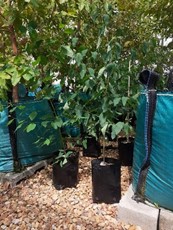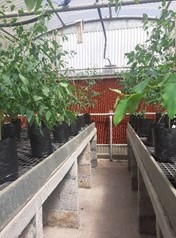
The Hans Merensky Chair in Measuring and Modelling Eucalypt Growth & Wood Formation
Understanding growth in the world's most widely planted hardwoods
The effects of temperature and water availability on the water use efficiency of two Myrtacae species, Eucalyptus grandis and Syzygium guineense
Post authored by Yenziwe Mbuyisa
Yenziwe Mbuyisa, a M.Sc. candidate, is looking at the water use efficiency of different Eucalyptus clones using stable isotopes. This project is a collaborative effort between EucXylo and the Global Change Biology Group (GCBG) under the supervision of Prof. Guy Midgley and Prof. Dave Drew.
The opportunity of climate change mitigation through global tree afforestation/reforestation programs has become the flavour of the decade. With the likelihood of increasingly frequent and severe droughts and heat waves being a major cause for concern, understanding how trees respond to temperature extremes and limited water availability is critical to forecasting both short and long-term impacts of climate change on forest systems in South Africa.
This study will evaluate the effects of ambient air temperature in concert with available water availability on the water use efficiency (WUE), physiology, and isotopic discrimination of two Myrtacae species; Eucalyptus grandis (a species originally from New South Wales) and Syzygium guineense (a local species found predominantly in the eastern parts of South Africa). Currently, the trees have been placed in a high tunnel structure where they are exposed to a temperature gradient stimulated by a built-in wet wall. Two water treatments will be applied to the trees to help determine whether WUE varies between the two species under different temperatures and whether δ13C can be used as a reliable signal of historic WUE.
(1) (2)
(2) (3)
(3) (4)
(4)
After transplantation the samples were placed in a shade netted nursery where they received light frequent above-head irrigation for 8 weeks (1). Thereafter, they were moved outside to the patchy canopy of some other eucalypts for 2 weeks (2). The samples are now acclimatizing to the conditions in the tunnel (3,4) before we can initiate the treatments and collect data.
Looking forward to start understanding how these two Myrtacae species will respond to predicted temperature variability and varying water availability.